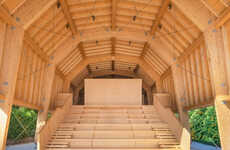
The Swiss Pavilion Takes a Retrospective Look at Architecture
Jamie Danielle Munro — June 20, 2014 — Art & Design
References: biennials.ch & designboom
The Swiss Pavilion is set up with various trolleys throughout a space, allowing for visitors to move throughout the area and understand the history of certain pieces of architecture. The name of the piece is called 'Lucius Burckhardt and Cedric Price – A Stroll Through a Fun Palace.'
The interior is quite stark, which allows each person to visit the respective areas and not be distracted by unwanted attractions. People are invited to interact with the material presented, and learn more about the history of architecture and where it's going in the future. Burckhardt and Price wanted to reinvent the idea of the pavilion, making it "a site for cross-disciplinary, interactive, international engagement," as DesignBoom states.
Photo Credits: designboom, biennials.ch
The interior is quite stark, which allows each person to visit the respective areas and not be distracted by unwanted attractions. People are invited to interact with the material presented, and learn more about the history of architecture and where it's going in the future. Burckhardt and Price wanted to reinvent the idea of the pavilion, making it "a site for cross-disciplinary, interactive, international engagement," as DesignBoom states.
Photo Credits: designboom, biennials.ch
Trend Themes
1. Interactive Pavilions - Creating pavilions that invite visitors to interact with the material presented, fostering cross-disciplinary engagement.
2. Stark Interior Design - Designing pavilions with a minimalist and distraction-free interior, allowing visitors to focus on the exhibits.
3. Retrospective Architecture - Developing pavilions that provide a historical perspective on architecture and its future direction.
Industry Implications
1. Architecture Exhibitions - Organizing exhibitions that showcase innovative pavilion designs and engage visitors in interactive experiences.
2. Museum and Gallery Design - Applying minimalist interior design principles in the creation of museums and galleries to enhance the visitor experience.
3. Historical Preservation - Using pavilions as a medium to educate the public about the history and significance of architecture for future preservation efforts.
1.2
Score
Popularity
Activity
Freshness























